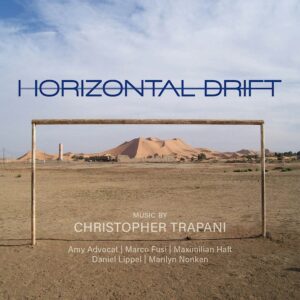Christopher Trapani – Horizontal Drift (CD Review)
Christopher Trapani
Horizontal Drift
New Focus Records
Christopher Trapani’s latest portrait recording for New Focus features pieces for solo instruments, several with electronics. The composer’s work with microtones and hybrid tuning systems is spotlighted. Trapani has a compendious knowledge of microtonality, and he brings it to bear eloquently in the programmed pieces.
The album’s opener, Târgul, is written for vioara cu goarna, a Romanian variant on the stroh violin, a violin with an added horn to provide greater projection. It also can provide fascinating timbres, as Maximilian Haft’s performance illuminates. Dan Lippel plays the title track on quarter tone guitar, abetted by real time electronics edited by a Max patch. It is a standout piece, with sinuous passages of quarter tones and glissandos followed and morphed by electronics. The use of complex arpeggiations is riveting.
Linear A is performed by clarinetist Amy Advocat. It uses still another tuning, the Bohlen-Pierce scale, which repeats at the twelfth instead of the octave. The electronics provide clarinet duets that make the already surreal environment of the scale enhanced by buzzing overtones. Lots of florid playing, which Advocat executes with aplomb.
Lost Time Triptych is an amalgam of influences. Written as a companion piece for Gerard Grisey’s Vox Temporum, it has three detuned pitches that play a pivotal role in the music. Each of the Triptych’s movements is subtitled with a phrase from Bob Dylan. Marilyn Nonken plays the piece with detailed balancing of its intricate harmonies and supple dynamic shading. Forty-Nine, Forty-Nine is for a 31-tone equal tempered Fokker organ that is controlled by MIDI rather than an organist. With a feisty analog demeanor,
it is reminiscent of some of the electronic pieces from the Columbia-Princeton Center,
The recording closes with Tessaræ, a piece written for the viola d’amore. This instrument has sympathetic strings, and Trapani deploys it to emulate folk music from Turkey and India that also has instruments with sympathetic strings. The viola d’amore’s capacities for harmonics and drones are set against a mournful mid-register melody. It is an affecting work that demonstrates Trapani’s capacity for emotional writing as well as technical innovation. Marco Fusi plays with a strongly delineated sense of the counterpoint employed in the piece.
Horizontal Drift is a compelling recording, demonstrating Trapani’s craft and imagination in equal abundance. Recommended.
